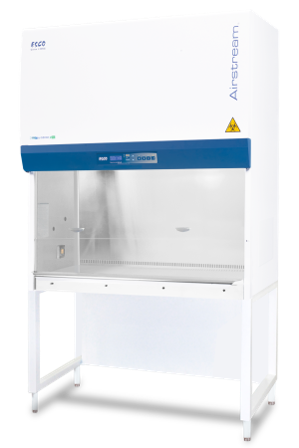
一种生物安全柜(BSC), also known as a Biosafety Cabinet is mainly used for handling pathogenic biological samples or for applications that require a sterile work zone. A biological safety cabinet creates inflow and downflow of air that provides operator protection. The downflow air passes through an ULPA/HEPA filter and creates an ISO Class 3 work zone to protect samples from the risk of cross-contamination. The air exhausted also passes through an ULPA/HEPA filter prior to release to protect the environment.
ESCO BioSafety柜有多种选择,从工作托盘,侧面板构造到配件。ESCO BSC的设计具有符合人体工程学和节能的功能。
为了确保生物安全柜的最佳性能,这些性能通过2标准进行了测试和分类:EN 12469:2000和NSF 49。

EN 12649
EN 12469:2000生物技术 - 微生物安全机柜的性能标准是欧洲标准化委员会CEN出版的新型微生物安全机柜的欧洲标准。该标准将BSC分为I类,II类和III类。

nsF
NSF International(以前是国家卫生基金会)生物安全橱柜计划是在1970年代应监管社区的要求启动的,包括疾病控制中心(CDC),美国国家卫生研究院(NIH)和国家癌症研究所(NCI)。该标准进一步根据基于空气循环的亚型进一步对II类生物安全柜进行分类:II类A1类,II类A2类A2,II类B1类和II类B2类。
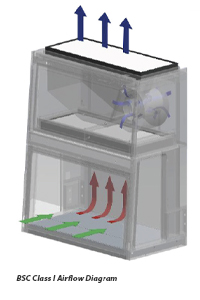
I类生物安全柜可保护操作员和环境免于暴露于生物危害。它不会阻止在机柜中处理样品,以暴露于房间空气中可能存在的污染物中。自然,有可能影响实验一致性的交叉污染。因此,I类机柜的范围和应用是有限的,并且在很大程度上被认为是过时的。
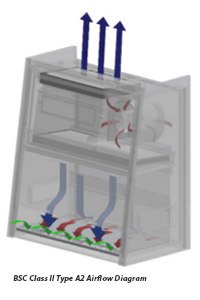
II类类型A2
II类A2生物安全柜是最常见的II类机柜。它具有一个元素,从中30%的空气被耗尽,并将70%的空气作为下降而重新传输到工作区域。
根据NSF/ ANSI 49:2010的说明,II类A1类和A2类都必须具有正压污染的元素,才能被负压包围。如果正气体发生泄漏,泄漏的气溶胶将被负压恢复到正气体的情况,并且不会泄漏。
一世n the A2 cabinet, about 70% of air from the positive plenum is recirculated as downflow, and the remaining 30% is discharged to the lab through the exhaust filter.
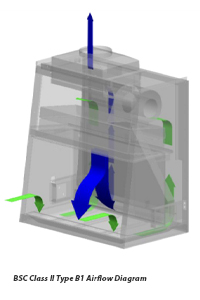
II类B1类
II类B1生物安全柜具有一个通用的全体会议,从中有70%的空气耗尽,并将30%的空气作为下降。该机柜还具有专用的排气功能,可以消除柜子内部的后部进行工作时的重新循环。仅当在下降中重新流通时,应允许使用作为微生物过程辅助的有毒化学物质。

II类B2类
the Class II Type B2 biosafety cabinets are suitable for work with toxic chemicals employed as an adjunct to microbiological processes under all circumstances since no re-circulation occurs. In theory, Type B2 biological safety cabinets may be considered as the safest of all Class II BSCs since the total exhaust feature acts as a fail-safe in the event that the downflow and / or exhaust HEPA filtration systems cease to function normally. However, Class II Type B2 biosafety cabinets require large laboratory spaces due to their installation system and will require elaborate ducting works.
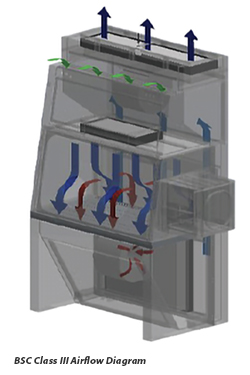
III类生物安全柜适合于分配给生物安全水平1、2、3和4的微生物剂的工作。它们经常被指定用于涉及最致命的生物学危害的工作。
work is performed through glove ports in the front of the cabinet. During routine operation, negative pressure relative to the ambient environment is maintained within the biosafety cabinet. This provides an additional fail-safe mechanism in case physical containment is compromised. On all Class III BSCs, a supply of HEPA filtered air provides product protection and prevents cross contamination of samples. Exhaust air is usually HEPA filtered and incinerated. Alternatively, double HEPA filtration with two filters in series may be utilized.
风险组是描述实验室中传染剂或毒素造成的相对危害的分类。
世界卫生组织(WHO)将风险群体定义为:
- 谁风险1-否或低个人和社区风险
- 谁风险2组2-适度的个人风险,低社区风险
- 谁风险3人3-个人风险高,社区风险低
- wHorisk Group 4- high individual and community risk
